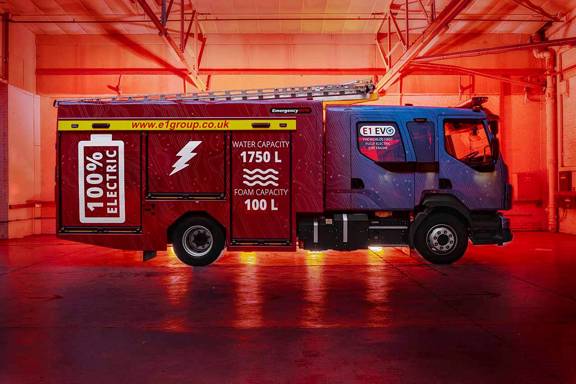How Emergency One is helping decarbonise global rescue services
Cumnock-based Emergency One is the UK’s leading manufacturer of fire and rescue appliances. We worked closely with the company to help it develop a groundbreaking, zero-carbon-emission emergency vehicle. Find out how its revolutionary solutions are supporting global emergency services.

9 Jan 2024 | 5 minute read
Emergency One (E-1) was established in 1989 and has since grown to become the UK’s leading manufacturer of specialist fire and rescue service vehicles.
Still headquartered in Cumnock where it was started, the company’s export presence has grown global branches from its proud Scottish roots.
E-1’s eight-acre site in the West of Scotland – from which many of its products make their way around the world – is not just a manufacturing site, but a home of innovation too.
Groundbreaking solutions for emergency services
With over three decades of expertise manufacturing specialist rescue appliances, E-1 is well versed in the challenges faced by the rescue services and the requirements of the machinery they use. This makes the company perfectly placed to evolve existing technology and develop innovative solutions – and that’s exactly what it's been doing.
E-1’s achievements to date include:
- helping supply Europe’s tallest turntable ladder on a fire engine
- contributing to the development of graphical user interfaces such as eCabControl and ePumpControl
- designing the E1 Scorpion™, a state-of-the-art ladder built for tackling fires at long range.
These innovations, while considerably improving safety and simplifying operations, could be considered minor when compared to the E1-EV0: the world’s first fully electric fire engine, which is designed, developed, and produced by Emergency One.
With the support of our innovation teams and a £500,000 grant, the company invested a combined £1.7 million towards the vehicle’s research and development.
The ground-breaking E1-EV0 was launched in October 2020 and represented a huge step forward in the global ambition to decarbonise emergency transport.

The E1-EV0 from Emergency One
Reducing the carbon footprint of emergency vehicles
Climate change is causing extreme weather conditions all over the world and is creating a vicious cycle. As hotter, dryer conditions increase the number of fire and rescue service vehicles needed, carbon emissions from the use of these vehicles are also increasing. This presents a unique challenge, particularly as fire and rescue services can’t employ many of the simple emission-reducing solutions used by other industries.
They can’t change their proximity to emergency locations to reduce the miles travelled, or reduce the size of their vehicles, and they can’t reduce the number of vehicles they operate. What they can do, though, is change the vehicles themselves.
However, sustainable emergency vehicles that meet the required industry specifications simply hadn’t existed until the E1-EV0.
The engineers at E-1 not only had to design a zero-emissions fire appliance, but they had to do it with the strict criteria imposed by the service requirements of an emergency vehicle.
They didn’t want to create a hybrid or concept vehicle that had limited range and operational performance. Instead, they tasked themselves with producing a next-generation solution that not only kept the features of the current model but also included new features that would improve safety for both firefighters and the public.
Sustainable emergency vehicles
Prior to the launch of the E1-EV0, Emergency One was already exporting to major overseas markets. But this revolutionary vehicle — with its bespoke capabilities and ability to be easily integrated into existing fleets — has the potential to expand even further.
Most recently, the E1-EV0 has been sold to France. This sale is expected to lead to several more across Europe, with many other countries showing interest in the vehicle.
The innovations used in the E1-EV0 can also be applied to evolutions of other existing appliances. For example, Emergency One is currently working with a US company to provide the E1-EV0 propulsion system for its vehicles. Other elements can also be further developed for different appliances – such as the solar panels that sit on its roof to provide renewable charging.
With the E1-EV0, Emergency One has demonstrated its ability to create revolutionary products that will help not just Scotland but the world achieve its net zero ambitions.
Learn more about Emergency One on the E-1 group website opens in a new window
Need advice on growing your sustainable business?
Our sustainability specialists are on hand to answer your questions and get you started on your journey to net zero.
-
Sign up to exporting email updates
Stay updated with the latest exporting and ecommerce news, events and international market opportunities for your business.
